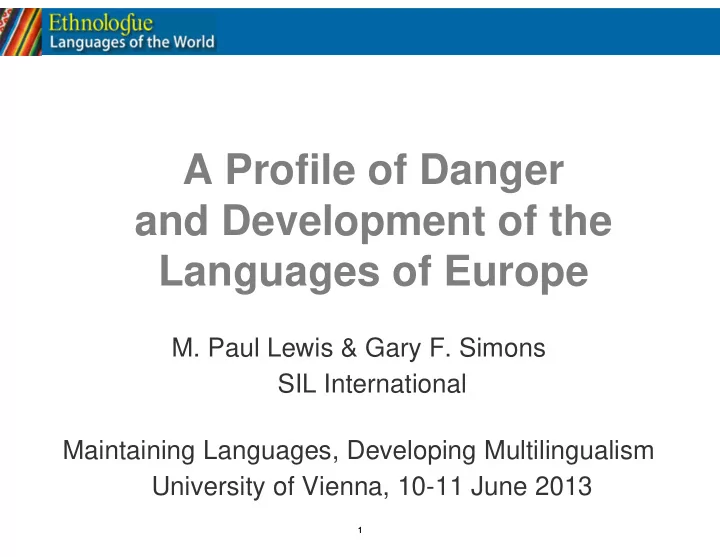

A Profile of Danger and Development of the Languages of Europe M. Paul Lewis & Gary F. Simons SIL International Maintaining Languages, Developing Multilingualism University of Vienna, 10-11 June 2013 1 1
Overview Expanded Graded Intergenerational Disruption Scale (EGIDS) as a means for assessing development versus endangerment of all the world’s languages European Charter for Regional and Minority Languages (ECRML) as a benchmark for language policy in Europe We use EGIDS to give a profile of the language situation in Europe and to explore the relationship between ECRML recognition and the status of languages 2 2
The basic premise of GIDS Language shift (ending in extinction) happens as a language loses functions in society To reverse language shift, the community must work to bring those functions back 1 2 3 Language Reversing 4 5 Shift Language 6 Shift 7 8 3 3
0 International The 13 levels 1 National 2 Provincial of EGIDS 3 Wider communication 4 Educational 5 Developing 6a Vigorous 6b Threatened Adapted from: Lewis, M. Paul and 7 Shifting Gary F. Simons. 2010. Assessing endangerment: Expanding 8a Moribund Fishman's GIDS. Revue Roumaine 8b Nearly Extinct de Linguistique 55(2):103-120. 9 Dormant http://www.lingv.ro/RRL%202%202010%20art0 1Lewis.pdf 10 Extinct 4
EGIDS (Lewis & Simons 2010) A 13-level scale that expands on Fishman’s GIDS (1991) by increasing its scope and giving greater internal precision Enables us to provide an estimate of relative danger and development for every language EGIDS 6a (Vigorous) is taken as the unmarked “norm” of sustainable oral use that represents the dividing line between endangerment (EGIDS 6b –10) and development (EGIDS 0 – 5) Broad and shallow analysis complementing more focused and deeper investigation 5 5
Vitality Profiles by World Regions (back) 6
Language status in Europe vs. Rest of world (as counts) n = 7,157 7 n = 323
7 Language status in Europe vs. Rest of world (as %s) (World Map) 8 8
Eastern Europe Western Asia UN Regions 9 Southern Europe Northern Europe Western Europe
Language status by UN region (as counts) 10
10 Language status by UN region (as %s) (World Map) 11 11
Status of ECRML in European states Dark green — Both signed and ratified Light green — Signed, but not ratified White — Neither signed nor ratified Gray — Not a member state Source: http://en.wikipedia.org/wiki/European_Charter_for_Regional_or_Minority_Languages 12 12
Language status in countries that have ratified ECRML vs. those that have not n = 194 n = 126 13 13
Language status in countries that have ratified ECRML vs. those that have not (%) 14 14 13
Much more language endangerment where ECRML is not ratified Language status ECRML is ratified Not ratified Institutional 41 (33%) 47 (24%) Developing or 58 (46%) 55 (28%) Vigorous In trouble, Dying, 27 (21%) 92 (47%) or Extinct Totals 126 194 15
Language status in ECRML countries 16
Which languages are recognized? Official languages (EGIDS 1,2) of other countries 84% (99 of 118) are recognized vs. 40% (41 of 102) for other languages 100% of those with a population over 250,000 are recognized 0% are recognized if the government considers them to be a dialect of the national language (= blue dots on the scatter plot) 17 17
Which languages are recognized? For languages not official in any country and not a dialect of the national language 46% (41 of 90) are recognized with a greater preference for larger languages 50,000 and higher: 60% (12 of 20) are recognized Under 50,000: 41% (29 of 70) are recognized And a greater preference for languages that are written and vital » EGIDS 3–5: 57% (27 of 47) are recognized » EGIDS 6a–8b: 33% (14 of 43) are recognized 18 18
Language status in ECRML countries 84% 57% 33% recognized recognized recognized (excluding blue) 19
Summary & Conclusions The profile of Europe is unique, with a preponderance of developed and developing languages. Policy makes a difference in language maintenance and development though it is not by itself a sufficient cause. In spite of a policy focus on minority/minoritized languages, already Institutionalized languages receive more recognition than do less developed languages. The perilously endangered languages continue to receive less attention than needed. The EGIDS categories applied to the ECMRL recognitions are helpful in pointing out the tendency of governments to recognize the already strong and to fail to notice the weakest of the weak. 20 20
References Fishman, Joshua A. 1991. Reversing language shift. Clevedon, UK: Multilingual Matters Ltd. Fishman, Joshua A. (ed.) 2001. Can threatened languages be saved? Reversing language shift, revisited: A 21st century perspective. Multilingual Matters 116. Clevedon, UK: Multilingual Matters Ltd. Krauss, Michael. 1992. The world's languages in crisis. Language. 68(1):4-10. Laakso, Johanna, Anneli Sarhimaa, Sia Spilpoulou Åkermark and Ria Touvanen. 2013. ELDIA Comparative Report . ELDIA Project. Leonard, Wesley Y. 2008. When is an "extinct language" not extinct? Miami, a formerly sleeping language. In King, Kendall A., Natalie Schilling-Estes, Lyn Fogle, Jia Jackie Lou and Barabara Soukup (eds.), Sustaining linguistic diversity Endangered and minority languages and language varieties. pp. Text 23--34. Washington D.C: Georgetown University Press. Lewis, M. Paul and Gary F. Simons. 2010. Assessing endangerment: Expanding Fishman's GIDS. Revue Roumaine de Linguistique. 55(2):103-120. http://www.lingv.ro/RRL%202%202010%20art01Lewis.pdf. Lewis, M. Paul, Gary F. Simons and Charles Fennig (eds.) 2013. Ethnologue Languages of the World, 17th edition. Dallas: SIL International. Mufwene, Salikoko S. 2002. Colonisation, globalisation, and the future of languages in the twenty-first century. International Journal on Multicultural Societies. 4:162-193 Simons, Gary F. and M. Paul Lewis. Forthcoming. The world's languages in crisis: A 20 year update. In Mihas, Elena, Bernard Perley, Gabriel Rei-Doval and Kathleen Wheatley (eds.), Proceedings of the 26th Linguistics Symposium, University of Wisconsin, Milwaukee. Amsterdam/Philadelphia: John Benjamins. 21 21
Thank You! gary_simons@sil.org paul_lewis@sil.org 22 22
Recommend
More recommend